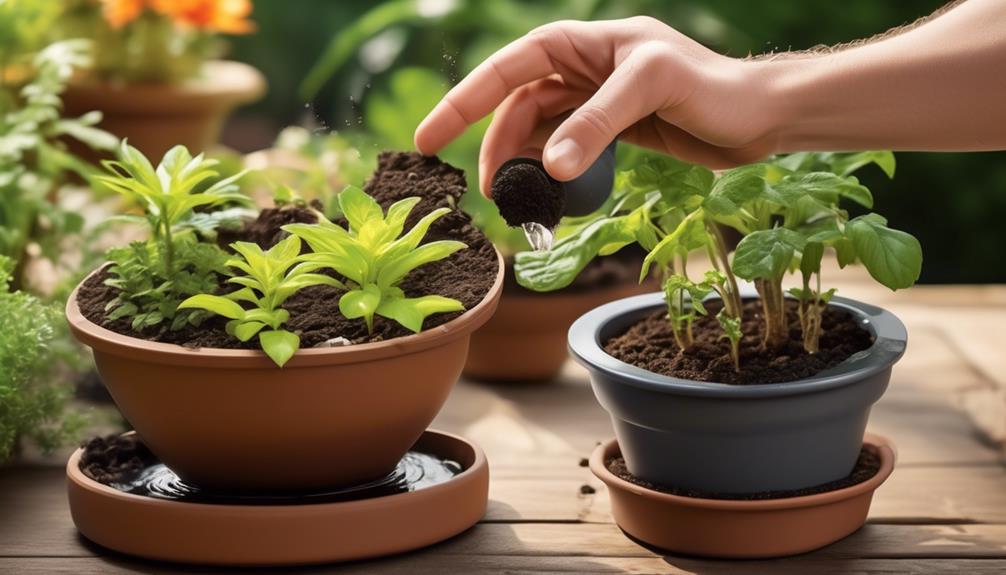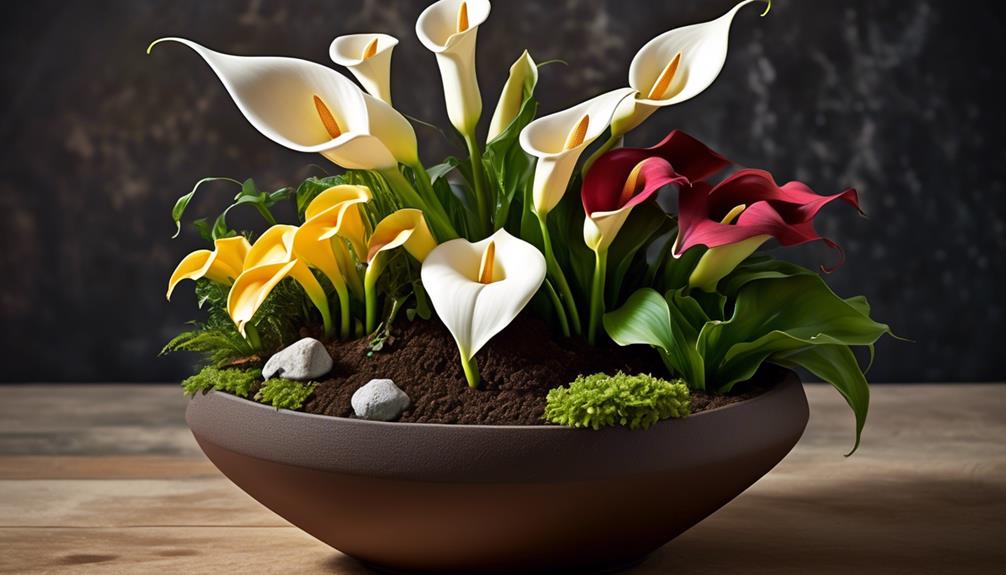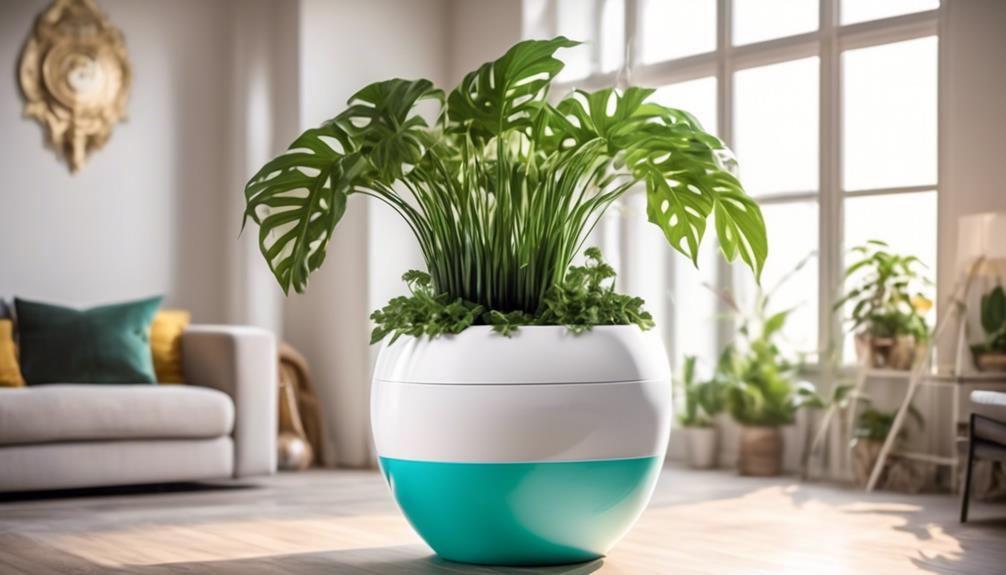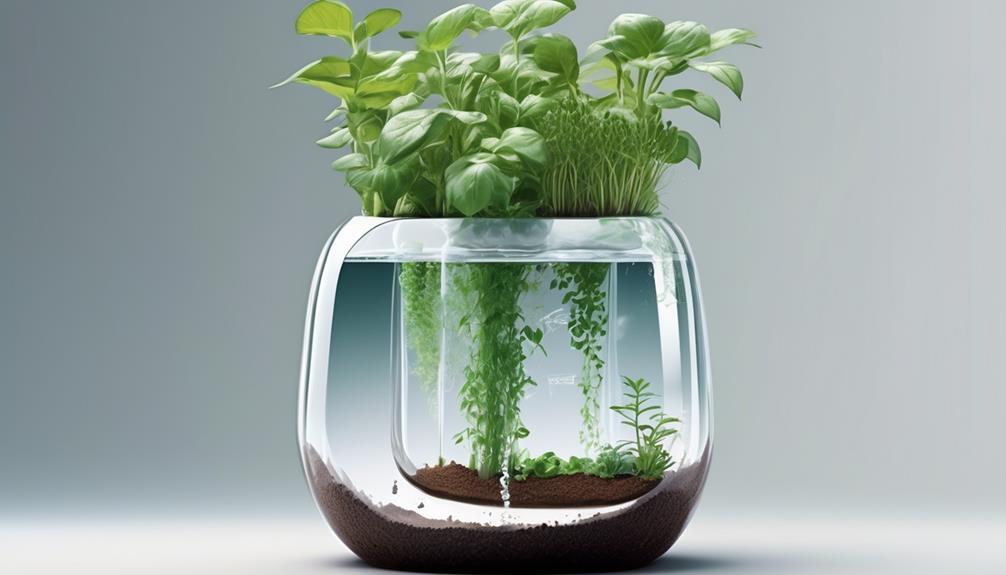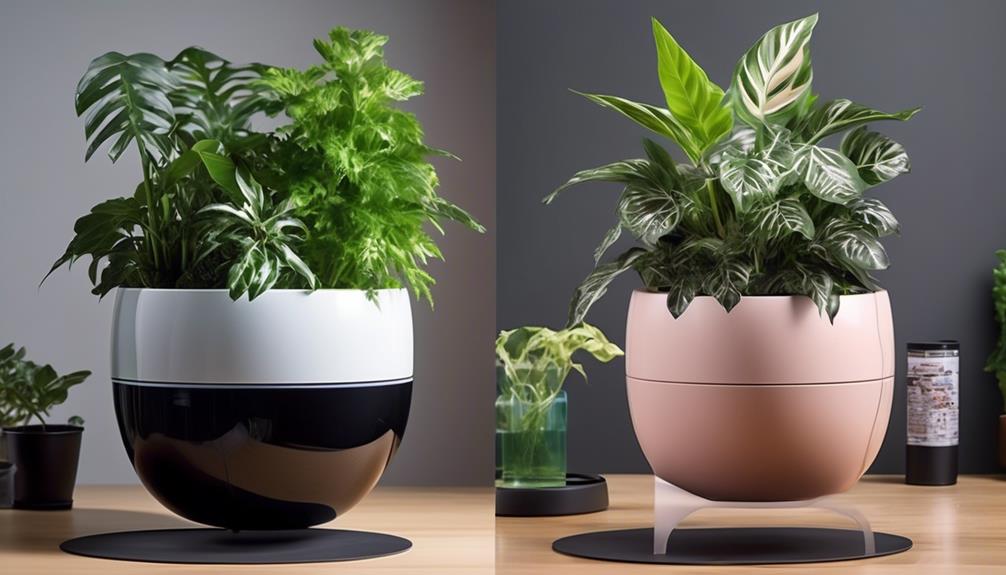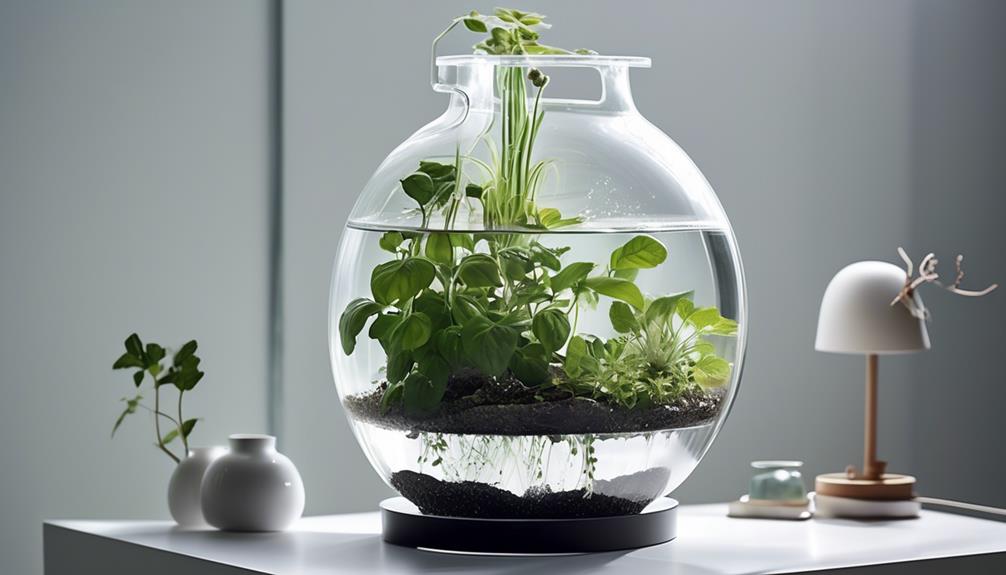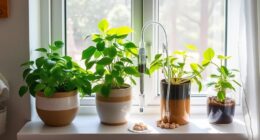We have all been in the situation where we forget to water our plants and they start to wilt and desperately need water. Did you know that self-watering planters can reduce water usage by up to 80% compared to traditional pots?
But how do we make the most of these innovative containers? Let's explore the ins and outs of planting in self-watering pots, from choosing the right potting mix to troubleshooting common issues.
Whether you're a seasoned gardener or just starting out, there's always something new to learn about this convenient and efficient way of nurturing your greenery.
Key Takeaways
- Self-watering pots reduce watering frequency and prevent overwatering.
- Choosing the right potting mix is crucial for healthy growth.
- Regular cleaning and maintenance of the self-watering reservoir is important.
- Selecting suitable plants and proper care ensure successful planting in self-watering pots.
Understanding Self-Watering Pots
Understanding self-watering pots can greatly simplify the task of watering your plants by providing a reservoir for water at the bottom of the pot that allows for a more controlled and consistent moisture level. One of the key benefits of self-watering pots is the reduction in watering frequency. These pots have a built-in mechanism that draws water up from the reservoir into the soil as the plant needs it, extending the time between watering sessions. This feature is particularly advantageous for busy individuals or those who may be prone to forgetting to water their plants regularly.
The benefits of self-watering pots are manifold. They not only reduce the frequency of watering but also help in preventing overwatering, a common issue that can lead to root rot and other plant diseases. The reservoir at the bottom of the pot ensures that the plant has access to water as needed, promoting healthier root development. Additionally, these pots provide a more consistent moisture level, which is especially beneficial for plants that require a stable environment.
Choosing the Right Potting Mix
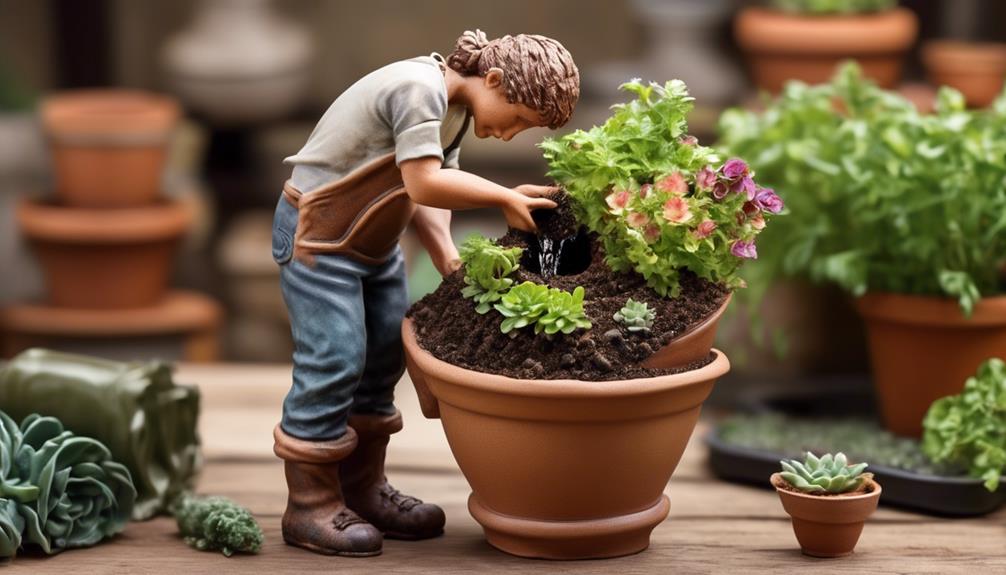
After learning about the benefits of self-watering pots and their role in maintaining consistent moisture levels for plants, it's crucial to select the right potting mix to further support healthy growth and hydration. When choosing the right potting mix, we need to consider the watering frequency, nutrient requirements, and the overall health of plants. Here's what to keep in mind:
- Watering Frequency: The potting mix should have good water retention properties to ensure that the soil remains consistently moist without becoming waterlogged. This is especially important in self-watering pots where the moisture levels need to be carefully regulated.
- Nutrient Requirements: The potting mix should provide essential nutrients for the plants, promoting healthy growth and development. Look for mixes that include a balanced blend of organic matter, perlite, vermiculite, and other natural additives to support the plant's nutritional needs.
- Soil Aeration: Aeration is crucial for root health. The potting mix should be well-draining and aerated to prevent root rot and promote oxygen flow to the roots.
- pH Balance: Consider the pH requirements of the specific plants you're growing and choose a potting mix that aligns with those needs. pH can impact nutrient availability, so it's essential to ensure the potting mix supports the ideal pH range for your plants.
Preparing the Self-Watering Reservoir
To prepare the self-watering reservoir, ensure that the wicking system components are securely in place within the pot to facilitate efficient water distribution to the potting mix. This includes checking that the wick is properly inserted into the soil and the water reservoir is clean and free from debris. Here's a simple guide to help you maintain the self-watering reservoir:
| Reservoir Maintenance | Watering Frequency |
|---|---|
| Check for clogs or algae growth in the reservoir. | Water plants as needed, typically every 1-2 weeks. |
| Clean the reservoir regularly to prevent blockages. | Adjust watering frequency based on plant needs and environmental conditions. |
| Ensure the water level is maintained at the appropriate level. | Monitor soil moisture and adjust watering as necessary. |
Regularly inspecting and maintaining the self-watering reservoir is crucial for the overall health of your plants. It ensures that the water supply is consistent and free from any potential issues that could impact plant growth. Additionally, monitoring the watering frequency based on individual plant needs and environmental factors will help promote healthy growth and prevent over or under-watering.
Selecting Suitable Plants for Self-Watering Pots
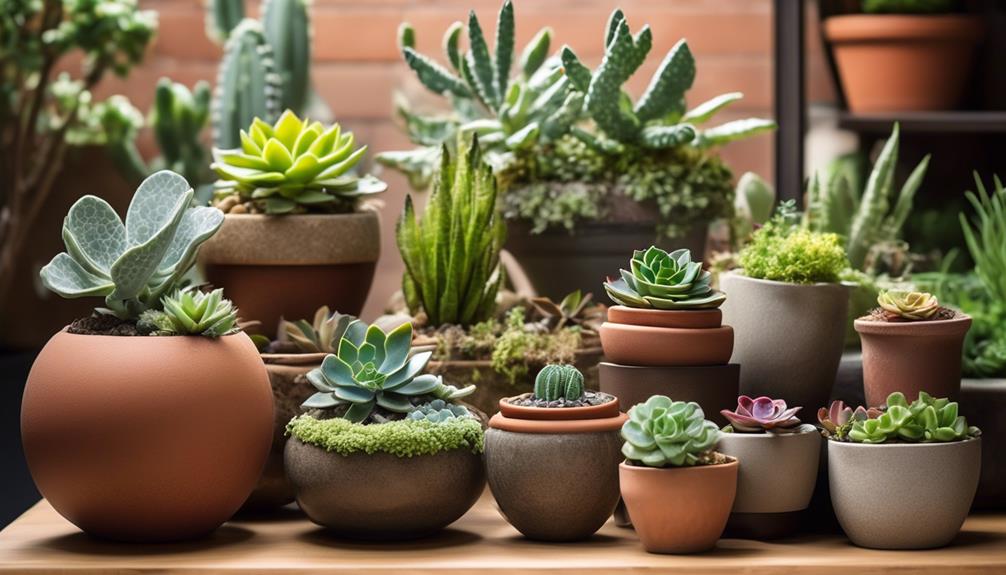
When selecting plants for self-watering pots, we need to consider:
- The size of the plant: The plant size should be appropriate for the size of the self-watering pot to ensure it has enough space to grow.
- Water requirements: Understanding the water needs of the plant is crucial for successful growth in a self-watering system.
- Root structure: Understanding the root structure of the plant is also important, as certain plants may have deep or shallow roots that may or may not be compatible with a self-watering pot.
Taking all of these factors into account will help ensure that the plants selected for self-watering pots have the best chance of thriving in this type of watering system.
Plant Size
Selecting suitable plants for self-watering pots requires careful consideration of their mature size, growth habits, and water needs to ensure optimal performance and long-term health. When choosing plants for self-watering pots, it's important to match the plant's growth characteristics with the pot size to create an ideal environment for healthy development.
Here's what to consider:
- Mature Height and Spread: Understanding the maximum size a plant will reach helps in selecting an appropriately sized pot.
- Root System: Consider the root structure of the plant to ensure it has enough space to grow and access water without becoming root-bound.
- Water Needs: Different plants have varying water requirements, so it's essential to match their needs with the self-watering pot's capabilities.
- Growth Rate: Some plants grow rapidly, while others have a slower growth rate. Matching the growth rate with the pot size ensures harmonious development.
Water Requirements
Understanding the water requirements of different plants is crucial for ensuring their optimal performance in self-watering pots, building upon our previous consideration of plant size and growth habits. When selecting plants for self-watering pots, it's essential to take into account their watering frequency and how it aligns with the pot's self-watering system. The table below outlines the general water requirements of various plant types, considering factors such as soil moisture and root development.
| Plant Type | Watering Frequency | Ideal Soil Moisture | Optimal Root Development |
|---|---|---|---|
| Succulents | Low | Dry | Shallow |
| Herbs | Moderate | Medium | Moderate |
| Leafy Greens | High | Moist | Deep |
Matching a plant's water needs with the self-watering pot's capabilities is vital for successful growth. This understanding ensures that the plants receive adequate moisture for their growth without the risk of overwatering.
Root Structure
Considering the root structures of plants is essential when choosing suitable candidates for self-watering pots. Understanding root development is crucial for watering efficiency.
Certain plants, like succulents and cacti, have shallow root systems and are well-suited for self-watering pots. In contrast, plants with deeper, extensive root structures, such as tomatoes and peppers, may not thrive in these pots due to limited soil depth.
The soil structure within self-watering pots also impacts moisture distribution, affecting plant growth and health. Plants with fibrous root systems, like herbs and lettuces, benefit from the consistent moisture levels provided by self-watering pots. Additionally, plants with taproots, such as carrots and radishes, may require deeper soil and thus mightn't be ideal for this type of container.
Transferring Plants Into the Pot
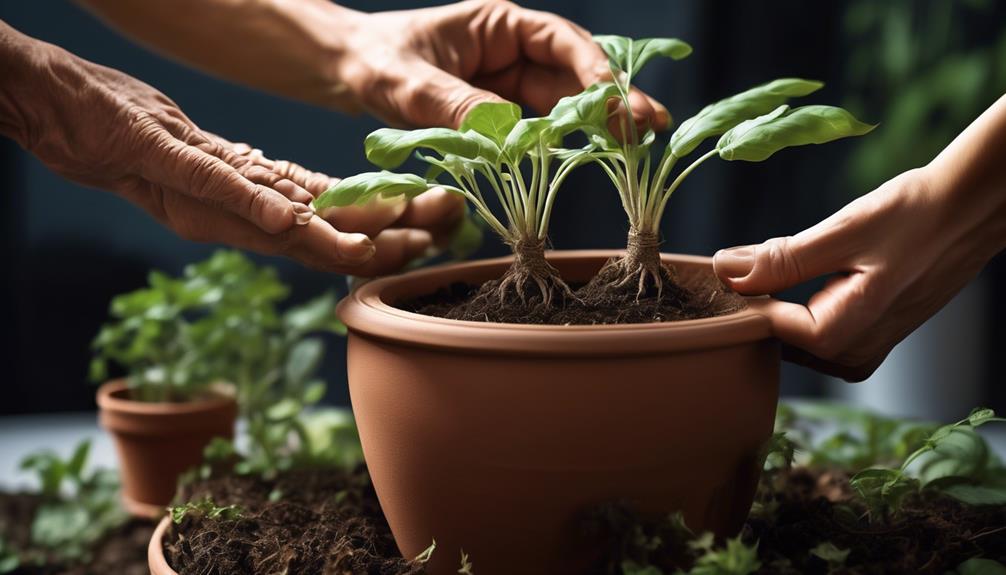
After carefully selecting the appropriate size of self watering pot for your plant, we can proceed with transferring the plant into the pot. When transferring a plant into a self watering pot, it's crucial to choose a pot that provides ample space for the plant's root system to grow and thrive. The pot size should be proportional to the plant's current root structure, allowing for some room for growth.
Before transferring the plant, ensure that the pot's self watering system is working correctly and that the pot environment is conducive to plant health.
To begin the transfer, gently remove the plant from its current pot, being mindful not to damage the roots. Next, place the plant into the self watering pot, ensuring that the top of the root ball sits just below the rim of the pot. Once the plant is in position, carefully fill the remaining space in the pot with soil, ensuring that the plant is stable and upright.
After the plant is securely in place, water it thoroughly and adjust the self watering system as needed to maintain a healthy pot environment.
Transferring plants into self watering pots requires attention to detail and consideration for both the plant's health and the pot environment. By following proper transferring techniques and selecting the right pot size, you can ensure that your plants thrive in their new self watering pots.
Setting Up the Watering System
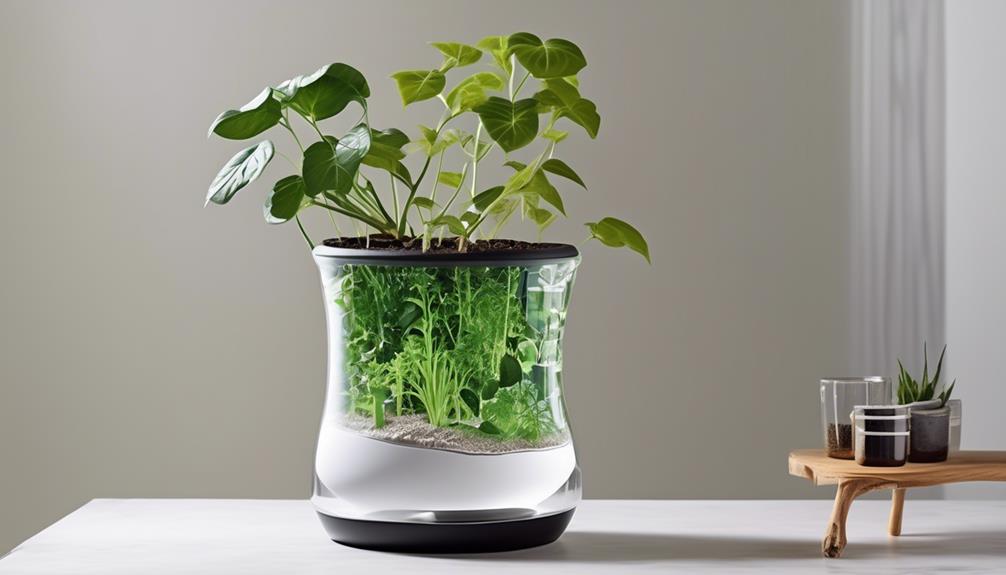
To set up the watering system for your self watering pot, carefully adjust the watering mechanism to provide the appropriate moisture level for your plant. Here's how you can ensure that your self watering pot functions effectively:
- Watering Frequency: Determine the specific watering needs of your plant and set the watering mechanism accordingly. This ensures that your plant receives the right amount of water at the right time, promoting healthy growth.
- Maintenance Schedule: Regularly check the water level indicator to ensure that the reservoir has an adequate supply of water. Adjust the watering mechanism as needed based on the moisture level of the soil to prevent overwatering or underwatering.
- Setting Up: Follow the manufacturer's instructions to properly set up the watering system. Ensure that all components, such as the watering tube and water reservoir, are securely in place to prevent any leaks or malfunctions.
- Maintenance: Clean the watering system regularly to prevent clogs and ensure proper water flow. This maintenance routine helps to keep the system functioning optimally and provides a healthy environment for your plant.
Monitoring Water Levels
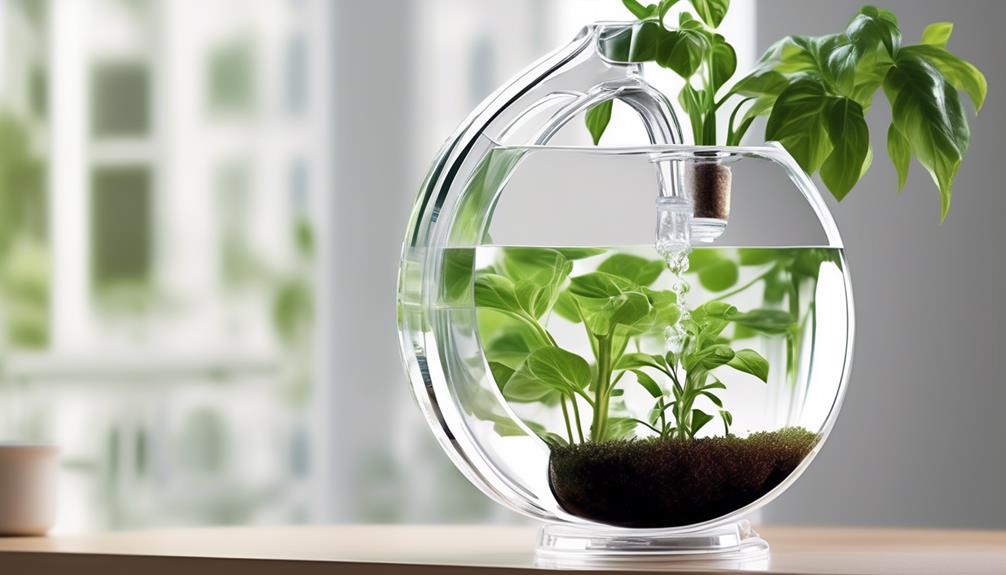
We regularly monitor the water level indicator to ensure that the reservoir maintains an adequate supply of water for optimal plant growth. The water level indicator is a crucial tool for gauging the water needs of the plant. By observing the indicator, we can determine if the reservoir requires a refill.
This is particularly important in self-watering pots as it directly impacts the watering frequency and the soil moisture. Monitoring the water level also helps prevent under or overwatering, which can be detrimental to plant health. When the water level is low, it's a clear indication that the reservoir needs to be refilled. On the other hand, if the water level remains consistently high, it may signal excessive watering or poor drainage.
Providing Adequate Sunlight
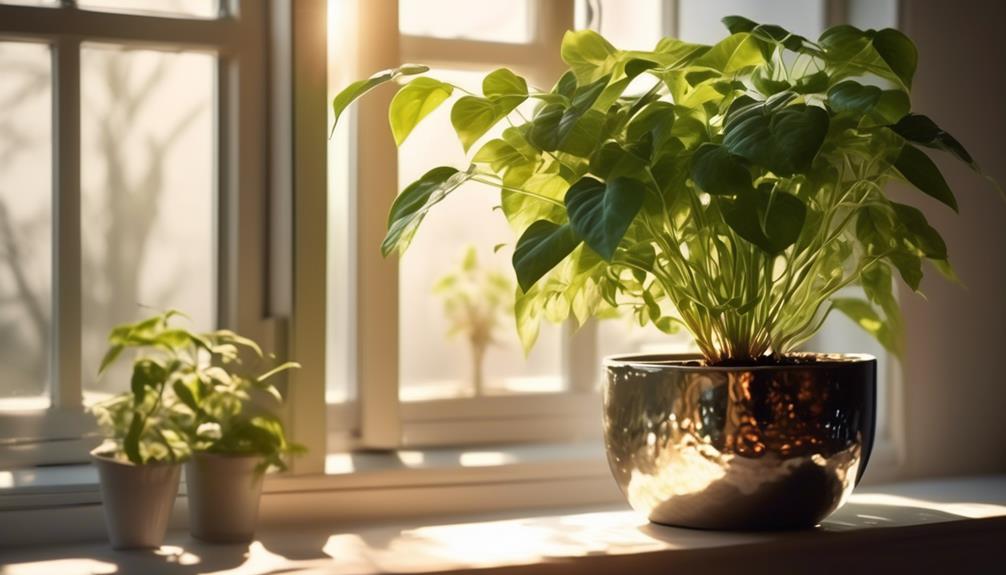
We need to consider three crucial factors when it comes to providing adequate sunlight for plants in self-watering pots: duration, intensity, and direction.
First, we must ensure that the plants receive the right amount of sunlight each day, as different plants have varying sunlight requirements.
Additionally, it's important to place the self-watering pots in locations where they can receive the appropriate intensity of sunlight for their specific needs.
Lastly, we should pay attention to the direction from which the sunlight comes, as this can affect how the plants receive and utilize the light.
Sunlight Duration
Properly positioning self-watering pots to receive at least 6-8 hours of direct sunlight each day is crucial for ensuring the health and vitality of the plants. Adequate sunlight exposure is essential for promoting robust plant growth, while proper sunlight distribution contributes to overall plant health.
When considering sunlight duration, it's important to:
- Place the self-watering pots in a location that receives the maximum amount of sunlight during the day.
- Adjust the positioning of the pots as the seasons change to ensure consistent sunlight exposure.
- Use reflective materials or surfaces to maximize sunlight absorption by the plants.
- Monitor the plants regularly to ensure they're receiving the required amount of sunlight for optimal growth.
Sunlight Intensity
To ensure optimal growth and development of plants in self-watering pots, it's essential to provide adequate sunlight intensity throughout the day. Sunlight exposure directly impacts plant growth, so it's crucial to understand the sunlight requirements of the specific plants you're growing.
Different plants have varying needs; for instance, vegetables generally require at least 6-8 hours of direct sunlight each day, while some flowering plants may thrive with slightly less. When placing self-watering pots, consider the sunlight intensity in different areas of your outdoor space. Utilize sunny spots for sun-loving plants and shadier areas for those that prefer less sunlight.
Monitoring the sunlight intensity throughout the day and adjusting the placement of your self-watering pots accordingly will ensure that your plants receive the optimal amount of sunlight for healthy growth.
Sunlight Direction
Positioning the self-watering pots to maximize exposure to direct sunlight throughout the day is crucial for the optimal growth of the plants. When considering sunlight direction, the following factors should be taken into account:
- Place the pots in a location where they receive at least 6-8 hours of direct sunlight daily. This ensures that the plants get enough sunlight to thrive.
- Orient the pots in a way that ensures even sunlight exposure to all sides of the plant. This may require rotating the pots occasionally to avoid uneven growth.
- Avoid placing the pots in areas with potential obstructions such as tall buildings or trees. These obstructions can cast shadows and limit sunlight exposure, which can hinder the plant's growth.
- Utilize reflective surfaces or light-colored walls to bounce sunlight onto the plants. This is particularly important in areas with limited direct sunlight, as it helps to maximize the amount of sunlight the plants receive.
Fertilizing in Self-Watering Pots

When fertilizing in self-watering pots, it's important to choose a balanced, water-soluble fertilizer to provide essential nutrients to the plants. The application of fertilizer in self-watering pots requires careful consideration to prevent over-fertilization, which can lead to salt build-up in the reservoir. It's recommended to dilute the fertilizer to half the recommended strength to avoid damaging the plant roots.
Nutrient management in self-watering pots is crucial as the water supply can impact the availability of nutrients to the plants. Therefore, regular monitoring of nutrient levels and plant growth is essential to adjust the fertilization regimen accordingly.
To apply fertilizer in self-watering pots, simply add the diluted solution directly to the water reservoir. This allows the plants to access the nutrients as they draw water from the reservoir, ensuring a consistent supply of essential elements. It's important to follow the manufacturer's instructions for the specific fertilizer being used and to avoid applying fertilizer directly to the soil, as this can lead to an imbalance in the water reservoir.
Proper fertilizer application and nutrient management are key components of successful plant care in self-watering pots.
Troubleshooting Common Issues
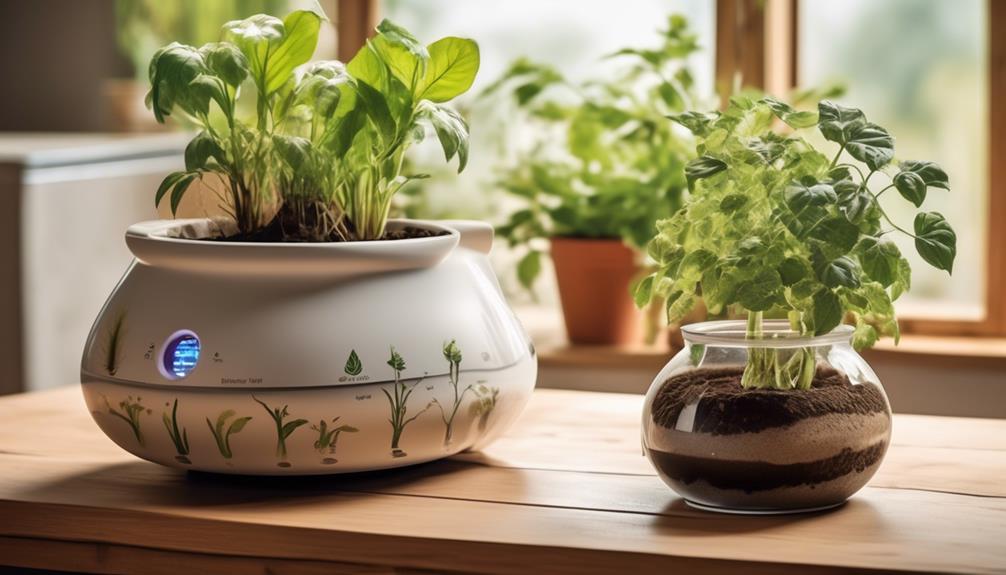
As we troubleshoot common issues in self-watering pots, it's essential to monitor the nutrient levels and plant growth to ensure that any problems are addressed promptly and accurately.
When troubleshooting drainage in self-watering pots, consider the following tips to maintain optimal plant health:
- Check Soil Moisture: Regularly assess the soil moisture to ensure it's neither too dry nor waterlogged, as this can affect the plant's root health and growth.
- Inspect Drainage Holes: Examine the drainage holes to ensure they aren't clogged, as this can lead to water accumulation and root rot.
- Evaluate Water Levels: Monitor the water reservoir to ensure it's functioning properly and not overfilling, which can drown the plant roots.
- Adjust Pot Placement: Assess the pot's placement to ensure it's receiving the right amount of sunlight and air circulation, as improper placement can affect drainage and overall plant health.
Enjoying Low-Maintenance Plant Care
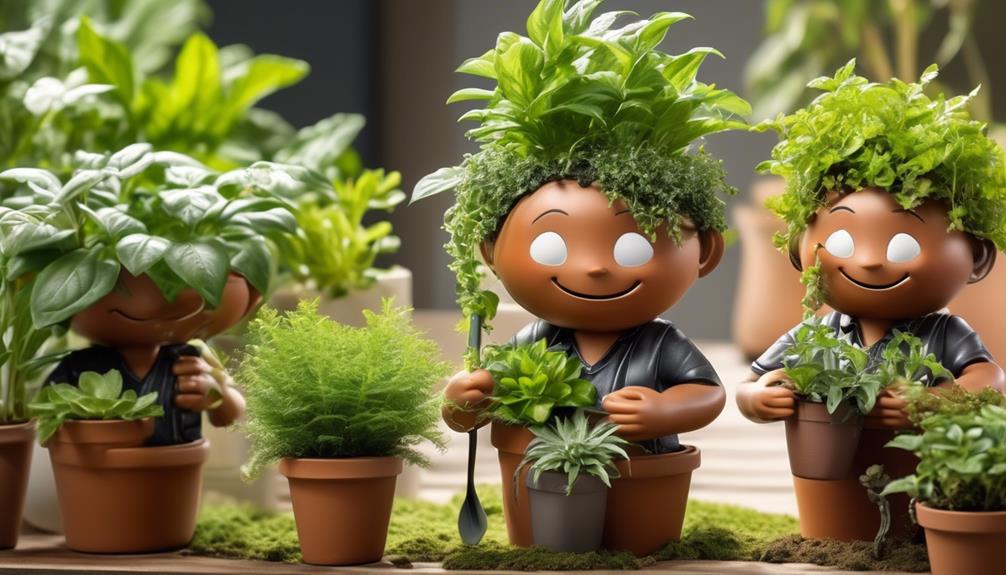
We've found that self-watering pots make watering easy and plant care simple.
With a built-in reservoir, these pots provide a consistent water supply to the plants, reducing the need for frequent watering.
This low-maintenance approach allows us to enjoy healthy, thriving plants with minimal effort.
Watering Made Easy
To ensure optimal plant health and reduce maintenance, self-watering pots provide a convenient and efficient way to regulate moisture levels. With these pots, watering becomes a breeze, allowing us to enjoy the benefits of simplified gardening.
Here are some key features that make watering with self-watering pots a seamless experience:
- Consistent Moisture Levels: The pots ensure a steady supply of water to the plant, preventing underwatering or overwatering.
- Reduced Watering Frequency: The reservoir design allows for less frequent refills, saving time and effort.
- Root Health Promotion: The wicking system encourages healthy root growth by providing water as needed.
- Peace of Mind: With self-watering pots, we can confidently leave our plants unattended for extended periods without worrying about dehydration.
These elements combine to make watering an effortless and worry-free task, enhancing the overall gardening experience.
Plant Care Simplified
Sustaining healthy plants with minimal effort can be achieved through embracing low-maintenance plant care, building upon the efficient watering methods previously discussed with self-watering pots.
When it comes to watering frequency, self-watering pots offer a significant advantage. The reservoir at the bottom provides a steady supply of water to the plant, reducing the need for frequent watering.
Monitoring soil moisture is crucial for plant care. With self-watering pots, the soil moisture is more consistent, and the risk of overwatering or underwatering is minimized. By ensuring the soil moisture remains within the optimal range, plant care becomes simplified.
This low-maintenance approach allows us to enjoy healthy and thriving plants while minimizing the time and effort required for their care.
Frequently Asked Questions
Can Self-Watering Pots Be Used for All Types of Plants, Including Succulents and Cacti?
Yes, self-watering pots can be used for all types of plants, including succulents and cacti.
Succulent care in self-watering pots should consider reduced watering frequency to prevent root rot.
For cacti, pot size and drainage are critical for growth.
It's essential to adjust the watering system to suit the specific needs of succulents and cacti.
Understanding these guidelines will help ensure successful growth in self-watering pots for all plant types.
Are There Any Specific Types of Fertilizers That Should Be Used With Self-Watering Pots?
When it comes to fertilizing in self-watering pots, we've found that using a balanced liquid fertilizer diluted to half strength is ideal. This ensures that your plants receive the necessary nutrients without overwhelming the soil's moisture levels.
When applying the fertilizer, it's essential to consider the soil composition and the existing moisture levels to prevent any imbalance. This approach promotes healthy growth and minimizes the risk of overfertilization.
How Often Should the Water Reservoir in a Self-Watering Pot Be Cleaned and Refilled?
We clean and refill the water reservoir in self-watering pots every 2-4 weeks, depending on the plant's water needs. These pots benefit busy gardeners by minimizing watering frequency.
Cleaning frequency ensures optimal water quality and prevents algae growth. To clean, remove old water, scrub the reservoir, and refill with fresh water.
This maintenance routine helps plants thrive and reduces the risk of water-related issues.
Can Self-Watering Pots Be Used in Outdoor Garden Settings, or Are They Best Suited for Indoor Use?
We've found that self-watering pots can be used both in outdoor garden settings and indoor spaces. They offer benefits such as water conservation and reduced watering frequency, making them suitable for various plant types.
However, drawbacks include the potential for overwatering and the need to monitor the water reservoir. When using self-watering pots outdoors, it's essential to consider factors like sunlight exposure and weather conditions.
Are There Any Special Considerations for Using Self-Watering Pots in Areas With High Humidity or Extreme Temperatures?
Considerations for using self-watering pots in high humidity involve:
- Monitoring moisture levels to prevent overwatering.
- Maintenance includes regularly checking the water reservoir and adjusting watering frequency as needed.
The benefits of self-watering pots in high humidity include:
- Consistent moisture levels for plants.
In extreme temperatures, best practices include:
- Using pots with insulation properties.
Challenges involve:
- Regulating temperature fluctuations.
Advantages of using self-watering pots in extreme temperatures include:
- Promoting plant health.
- Reducing watering frequency.
Are There Specific Plants That Thrive in Self-Watering Pots?
Yes, some plants thrive when planting in self watering pots. Plants like peace lilies, spider plants, and pothos do well in self watering pots because they prefer evenly moist soil. These pots are great for busy people who may forget to water their plants regularly.
Conclusion
In conclusion, self-watering pots offer a convenient and low-maintenance way to care for your plants.
By understanding their design, choosing the right potting mix, and selecting suitable plants, you can enjoy healthy and thriving greenery with minimal effort.
With the proper preparation and care, self-watering pots can make gardening a breeze, allowing you to sit back and enjoy the beauty of your plants without the hassle of frequent watering.

